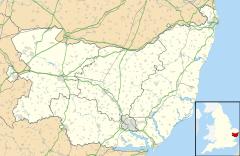Assington facts for kids
Quick facts for kids Assington |
|
|---|---|
 St Edmund's church, Assington. |
|
| Area | 11.20 km2 (4.32 sq mi) |
| Population | 402 (2011) |
| • Density | 36/km2 (93/sq mi) |
| OS grid reference | TL934381 |
| District |
|
| Shire county | |
| Region | |
| Country | England |
| Sovereign state | United Kingdom |
| Post town | SUDBURY |
| Postcode district | CO10 |
| Dialling code | 01787 |
| Police | Suffolk |
| Fire | Suffolk |
| Ambulance | East of England |
| EU Parliament | East of England |
| UK Parliament |
|
Assington is a small village in Suffolk, England. It is about 4 miles (6.4 km) south-east of Sudbury. In 2011, about 402 people lived there. By 2019, this number grew to an estimated 445. The area of Assington also includes two smaller places called Rose Green and Dorking Tye.
Contents
History of Assington
The name "Assington" means "homestead of Assi." This is according to a language expert named Eilert Ekwall. Before the Norman Conquest in 1066, a person named Siward Barn owned the village.
The Domesday Book was a big survey made in 1086. It shows that Assington had 78 households. This included villagers, freemen, smallholders, and slaves. The village also had many animals like cattle, pigs, and sheep. There were also beehives and a mill. The number of households was similar to today's population. At that time, Ranulf Peverel was the main lord of the village.
A church was already in Assington when the Domesday Book was written. This church is now called St Edmund's. Records show a vicar (a type of priest) in 1349. The church was officially named after St Edmund in 1459.
Historic Buildings in Assington
The main church in the village is dedicated to St Edmund the Martyr. It is built from flint and cut stone. The church was first built in the 1400s. It was repaired and made new again in the 1800s.
The church tower has six bells. The biggest bell weighs about 533 kg. All six bells were made and put in place in 1890. They were made by a company called John Warner & Sons. For now, the bells cannot be rung.
Assington Hall is a large house next to the church. It was the home of the Gurdon family for many years. John Gurdon (who lived from about 1544 to 1623) became a Member of Parliament for Sudbury, Suffolk, in 1571. His son, Brampton Gurdon (who died in 1648), also became a Member of Parliament in 1621. He later became an important official in Suffolk in 1629.
Later members of the Gurdon family helped local charities in the 1700s. Assington Hall was taken down in 1957 after a fire. But the stables and coach house are still there. They are listed as important historic buildings.
Transport in Assington
Assington has bus services from Monday to Saturday. These buses travel between Sudbury and Colchester during the day.
The closest train station is in Bures. This is about 3 miles (5 km) away. Trains run every hour from Bures to Marks Tey. From Marks Tey, you can catch trains to London and Colchester.
Amenities in Assington
The village has several useful places. There is a farm shop where you can buy local produce. There is also a pub and restaurant called the Shoulder of Mutton. Assington has a village hall for community events. You can also find a post office there. All these places are on The Street, which is off the main A134 road. This road connects Sudbury and Colchester.


